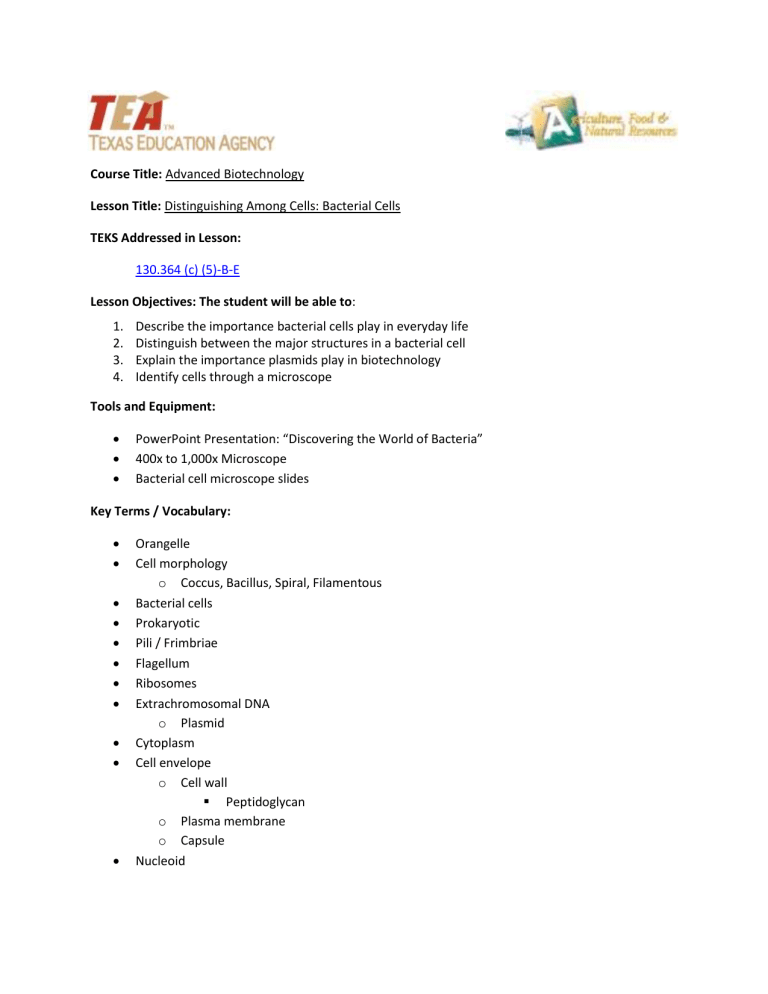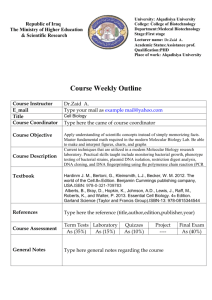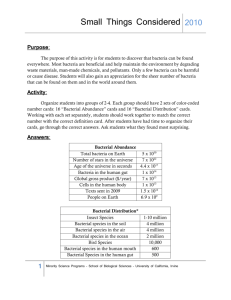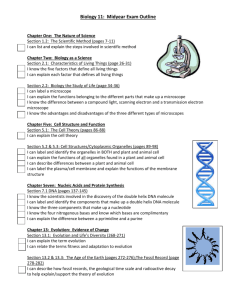05b Identifying Bacterial Cells LP

Course Title: Advanced Biotechnology
Lesson Title: Distinguishing Among Cells: Bacterial Cells
TEKS Addressed in Lesson:
130.364 (c) (5)-B-E
Lesson Objectives: The student will be able to:
1.
Describe the importance bacterial cells play in everyday life
2.
Distinguish between the major structures in a bacterial cell
3.
Explain the importance plasmids play in biotechnology
4.
Identify cells through a microscope
Tools and Equipment:
PowerPoint Presentation: “Discovering the World of Bacteria”
400x to 1,000x Microscope
Bacterial cell microscope slides
Key Terms / Vocabulary:
Orangelle
Cell morphology o Coccus, Bacillus, Spiral, Filamentous
Bacterial cells
Prokaryotic
Pili / Frimbriae
Flagellum
Ribosomes
Extrachromosomal DNA o Plasmid
Cytoplasm
Cell envelope o Cell wall
Peptidoglycan o Plasma membrane o Capsule
Nucleoid
Interest Approach/Anticipatory Set
What was the first form of life on Earth? They are the simplest forms of life, yet despite this simplicity, they are the building blocks of life. The number of bacteria exceeds the entire population of plants and animals on Earth; there exists approximately 5x10 30 bacteria on Earth, an almost incomprehensible number. Bacteria play such important role in the biosphere such as nutrient cycling, and allow the science of biotechnology to effectively work. Bacteria allows us to improve our lives.
Teaching Plan and Strategy / Presentation of New Material
Instructors should present information in the PowerPoint. Ensure that you describe the material in depth and how some terminology is the parent of other terminology. For example, a plasmid is extrachromosomal DNA. Cell envelope is the all-encompassing term for the shell which contains the cell wall, plasma membrane, and capsule.
Ask students questions throughout the lesson to allow them to utilize their existing knowledge of biology. For example: o We understand that chromosomes are, and what DNA is. What do you think the term
“extrachromosomal DNA” means? o What do structures do you think the cell envelope contains? o Why are plasmids important in biotechnology?
Have students fill out the note taking worksheet as you progress through the lesson. You can use this to make sure students take notes by using it as a completion grade.
Activity/Application/ Student Engagement /Laboratory
Bacterial Cell Activity: Under workstations with a 400x-1,000x microscope, have students insert a slide containing biological cells. You can make your own (yogurt is a good source); however, it may prove difficult. You can order kits of high-quality stained bacteria cell slides online for approximately $30-50.
Have students draw the cell on the worksheet accompanied with this lesson plan. Ask them to label the structures, describe the characteristics of these structures, and the importance they play in the cell.
Evaluation / Summary
Ask the following guided questions:
1.
Why are bacterial cells important?
2.
What are some important structures found in bacterial cells?
3.
What is the importance of the plasmid in biotechnology?
References/Additional Materials / Extended Learning Opportunities/ Enrichment http://biotechlearn.org.nz/themes/bacteria_in_biotech http://www.textbookofbacteriology.net/ http://www.cellsalive.com/cells/bactcell.htm
http://classes.midlandstech.edu/carterp/courses/bio225/chap04/lecture1.htm
College & Career Readiness Standard
Science I (D)(3)
Science IV (A)(1);(A)(2); (A)(3); (A)(6)
©Texas Education Agency, 2014











